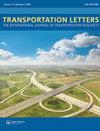使用 SHapley Additive exPlanations 解释基于深度学习的活动计划模型
IF 3.3
3区 工程技术
Q2 TRANSPORTATION
Transportation Letters-The International Journal of Transportation Research
Pub Date : 2025-03-16
DOI:10.1080/19427867.2024.2359304
引用次数: 0
摘要
在旅行行为文献中,人工神经网络经常因其黑箱性质而受到批评。缺乏对变量影响的理解导致对模型预测缺乏信心,严重影响其实际效用。本研究旨在通过SHapley加性解释来理解基于深度学习的活动计划模型中不同变量的影响,从而解决这一问题。活动时间表以时间序列表示,与以前的方法相比,能够以更精细的分辨率研究每个变量影响的时间变化。研究结果显示,诸如星期、月份和社会参与等变量对活动时间有显著影响,而家庭结构和城市阶层也有显著影响。这种提出的方法增强了我们对一天中不同时间的变量影响的理解,增强了对深度学习模型结果的信心,推进了它的实际应用。本文章由计算机程序翻译,如有差异,请以英文原文为准。
Explaining deep learning-based activity schedule models using SHapley Additive exPlanations
Artificial neural networks are often criticized for their black box nature in travel behavior literature. The lack of understanding of variable influence induces little confidence in model predictions, significantly affecting their practical utility. This study aims to address this issue by employing SHapley Additive exPlanations to understand the influence of different variables in a deep learning-based activity schedule model. The activity schedule is represented as a time series which enables the study of temporal variations in the influence of each variable at much finer resolutions compared to earlier approaches. The findings reveal that variables such as the day-of-week, month of the year, and social participation wield significant influence over the activity schedule, while household structure and urban class also exert noticeable impacts. This proposed methodology enhances our understanding of variable influences at different times of the day, instilling confidence in the deep learning model’s results, advancing its practical application.
求助全文
通过发布文献求助,成功后即可免费获取论文全文。
去求助
来源期刊

Transportation Letters-The International Journal of Transportation Research
TRANSPORTATION SCIENCE & TECHNOLOGY-
CiteScore
6.40
自引率
14.30%
发文量
79
审稿时长
>12 weeks
期刊介绍:
Transportation Letters: The International Journal of Transportation Research is a quarterly journal that publishes high-quality peer-reviewed and mini-review papers as well as technical notes and book reviews on the state-of-the-art in transportation research.
The focus of Transportation Letters is on analytical and empirical findings, methodological papers, and theoretical and conceptual insights across all areas of research. Review resource papers that merge descriptions of the state-of-the-art with innovative and new methodological, theoretical, and conceptual insights spanning all areas of transportation research are invited and of particular interest.
 求助内容:
求助内容: 应助结果提醒方式:
应助结果提醒方式:


